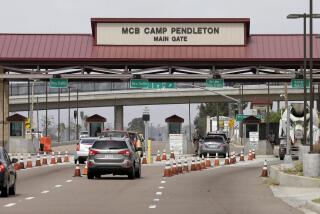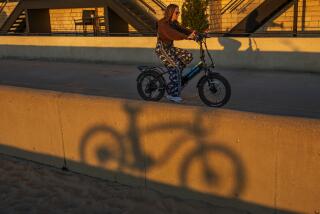A crash and a rush of responses
- Share via
High horsepower and diverse opinion exist in abundance on the issue of motorcycle safety, including from those who ride bikes, share the road with motorcycles, operate racing tracks and enforce the law.
An outpouring of e-mails from readers followed a column I wrote two weeks ago about a horrific crash in Long Beach that took the life of a Long Beach City College teacher and a student at the school. Police investigators have blamed the crash on a motorcyclist who was zooming along at 80 mph in a 25-mph construction zone.
Among readers’ suggestions are that inexperienced new riders need far more training, state laws should restrict younger riders from high-horsepower sport or racing bikes, and helmet laws need to be toughened in many states. If bikers want to speed, they can take their passion to the track.
“I cannot disagree with anything you said in the article and I am a lifelong motorcyclist,” wrote David Pyles of Alta Loma, who owns Fastrack Riders, which allows individuals to test their bikes in a controlled environment. “I try to get riders to quit racing on the streets and canyons and satisfy their need for speed in a safe and controlled environment.”
Pyles advocates better training, given the increasingly powerful sport bikes being sold to inexperienced riders. It is a concern echoed by B.K. Jackson, a Marine master sergeant stationed in Al Anbar province, Iraq.
“I teach my Marines about motorcycle safety, but more importantly, accountability and responsibility,” Jackson wrote. “I understand the public’s concern. Their concerns are my concerns. As a motorcyclist myself (not one of those ‘crotch rockets’ mind you), I often see and point out matters of concern in my periods of instruction. I’m with you, however, as it pertains to the law. We definitely need more stringent laws as they pertain to speeding, reckless endangerment, etc.”
A number of people said that the sport bike itself was not at fault in the Long Beach crash and contend that owners of sport bikes are actually less likely to crash. They say the rise in motorcycle crash deaths reflect an influx of older riders past their prime. By contrast, the older riders blame growing safety problems on the younger riders who buy the most powerful bikes and use them to speed.
William Johnston, who lives on the Palos Verdes Peninsula, has been riding sport bikes for years. “Never been ticketed for anything on a bike. Never had an accident or hit anything or anyone. Most of my peers who are riders have a similar pedigree. Crashing hurts, it’s expensive, it wrecks your bike and you look and feel like an idiot.”
Johnston no doubt represents the majority of motorcyclists. But a subculture exists.
“I have gotten several motorcycles on radar going very fast,” wrote Chris Knox, an L.A. County sheriff’s deputy who patrols the Rancho Palos Verdes area. “One was 85 mph in a 35-mph zone on PV Drive East [a curvy, steep road]. Because this is so dangerous, I book them at our station for reckless driving and impound the car or motorcycle for 30 days.”
Dave Bent wrote to protest what he sees as a glorification of powerful racing bikes.
“I was riding my motorcycle to high school in 1972 when I was struck broadside by a van,” Bent said. “I was not riding recklessly, I was just following another car that shielded me from the other driver’s vision. After four days in a coma, I did recover, but my life was forever altered. Despite subsequently having seven operations on my left foot, it is still broken and four of my toes are dislocated. I have lived in pain virtually every day since. I have always considered myself lucky to have survived at all.”
The Nov. 29 column noted that fatalities in motorcycle crashes have doubled in the last seven years. Most troubling is that motorcycles are crashing with an increasing frequency in terms of the broadest and most comprehensive measures. Between 1994 and 2004, fatalities in motorcycle crashes rose from 22.66 per million miles to 40 per million miles, an increase of 77%, according to the National Highway Traffic Safety Administration’s 2005 safety report on motorcycles. In the same period, fatalities in passenger cars were down 28%.
Of course, many fatal accidents are caused by car drivers.
“All of us riders have been run off the road, had things thrown at us, squeezed, cut off, and generally abused by blockheads in cars,” wrote John Fisher of Santa Barbara. “Imagine if all the cars had someone talking on a cellphone and you were driving a go-cart. That’s the sort of feeling riders have all the time.”
There is a flip side, expressed by Mike Burns of Yorba Linda, who rides a bicycle.
“I don’t hate motorcyclists,” Burns wrote. “I’ve owned several motorcycles over the years. Some of the local mountain highways have become unsafe racetracks for large organized groups of motorcyclists on weekends. Sometimes cyclists race for position; other times they attempt to [maintain an] average high speed over long stretches of road. The racers have radios on their helmets to communicate with spotters and dodge law enforcement.”
Still, federal statistics cast doubt on the assertion made by some motorcyclists that the vast majority of crashes are the fault of car drivers.
In 2005, there were 4,553 fatalities in motorcycle accidents, of which 44% occurred in single-bike accidents.
In any crash, motorcyclists, protected only by a helmet and perhaps special clothing, pay the stiffest price. Statisticians at the National Highway Traffic Safety Administration last week provided some new data on these crashes at my request.
Despite the mismatch in vehicle size, motorcycle crashes in 2005 took the lives of 50 people in other vehicles and also killed 38 pedestrians. The numbers were up sharply to the highest level in the last 15 years, along with other motorcycle fatalities.
*
ralph.vartabedian@latimes.com.







